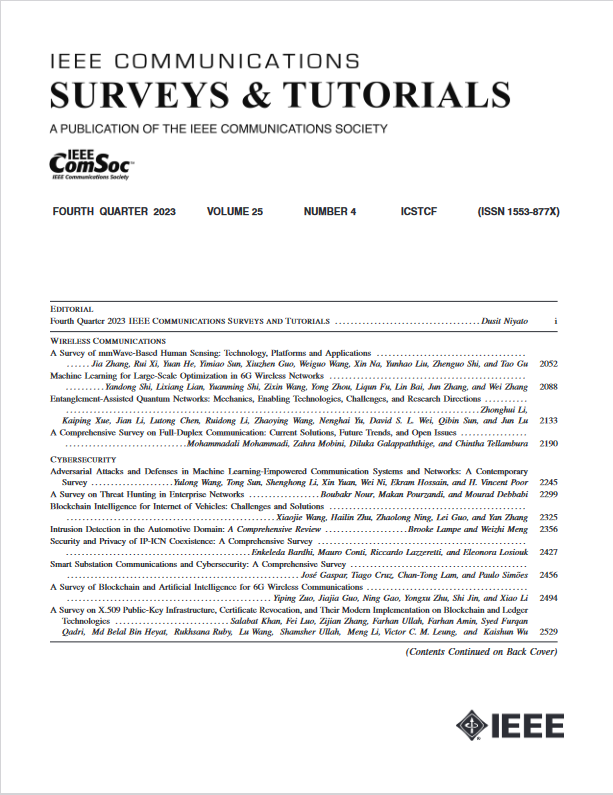机器学习驱动的加密网络流量分析:综合调查
IF 34.4
1区 计算机科学
Q1 COMPUTER SCIENCE, INFORMATION SYSTEMS
引用次数: 9
摘要
流量分析是监视网络活动、发现特定模式并从网络流量中收集有价值信息的过程。它可以应用于网络断言探测和异常检测等各个领域。然而,随着网络流量加密技术的出现,流量分析成为一项艰巨的任务。由于数据包有效载荷的不可见性,传统的依赖于从明文有效载荷中获取有价值信息的流量分析方法可能会失效。机器学习已经成为一种强大的工具,可以在不访问有效负载的情况下提取信息特征,因此被广泛应用于加密流量分析。在本文中,我们对机器学习驱动的加密流量分析的最新成就进行了全面的调查。首先,我们回顾了这一领域的文献,总结了作为文献分类基础的分析目标。然后,我们用机器学习工具抽象了加密流量分析的工作流程,包括流量采集、流量表示、流量分析方法和性能评估。在调查研究中,针对不同的分析目标,对分类粒度和信息时效性的要求可能会有很大的差异。因此,就流量分析的目标而言,我们根据网络资产识别、网络表征、隐私泄漏检测和异常检测四大类对现有研究进行了全面回顾。最后,讨论了加密流量分析面临的挑战和未来研究的方向。本文章由计算机程序翻译,如有差异,请以英文原文为准。
Machine Learning-Powered Encrypted Network Traffic Analysis: A Comprehensive Survey
Traffic analysis is the process of monitoring network activities, discovering specific patterns, and gleaning valuable information from network traffic. It can be applied in various fields such as network assert probing and anomaly detection. With the advent of network traffic encryption, however, traffic analysis becomes an arduous task. Due to the invisibility of packet payload, traditional traffic analysis methods relying on capturing valuable information from plaintext payload are likely to lose efficacy. Machine learning has been emerging as a powerful tool to extract informative features without getting access to payload, and thus is widely employed in encrypted traffic analysis. In this paper, we present a comprehensive survey on recent achievements in machine learning-powered encrypted traffic analysis. To begin with, we review the literature in this area and summarize the analysis goals that serve as the basis for literature classification. Then, we abstract the workflow of encrypted traffic analysis with machine learning tools, including traffic collection, traffic representation, traffic analysis method, and performance evaluation. For the surveyed studies, the requirements of classification granularity and information timeliness may vary a lot for different analysis goals. Hence, in terms of the goal of traffic analysis, we present a comprehensive review on existing studies according to four categories: network asset identification, network characterization, privacy leakage detection, and anomaly detection. Finally, we discuss the challenges and directions for future research on encrypted traffic analysis.
求助全文
通过发布文献求助,成功后即可免费获取论文全文。
去求助
来源期刊

IEEE Communications Surveys and Tutorials
COMPUTER SCIENCE, INFORMATION SYSTEMS-TELECOMMUNICATIONS
CiteScore
80.20
自引率
2.50%
发文量
84
审稿时长
6 months
期刊介绍:
IEEE Communications Surveys & Tutorials is an online journal published by the IEEE Communications Society for tutorials and surveys covering all aspects of the communications field. Telecommunications technology is progressing at a rapid pace, and the IEEE Communications Society is committed to providing researchers and other professionals the information and tools to stay abreast. IEEE Communications Surveys and Tutorials focuses on integrating and adding understanding to the existing literature on communications, putting results in context. Whether searching for in-depth information about a familiar area or an introduction into a new area, IEEE Communications Surveys & Tutorials aims to be the premier source of peer-reviewed, comprehensive tutorials and surveys, and pointers to further sources. IEEE Communications Surveys & Tutorials publishes only articles exclusively written for IEEE Communications Surveys & Tutorials and go through a rigorous review process before their publication in the quarterly issues.
A tutorial article in the IEEE Communications Surveys & Tutorials should be designed to help the reader to become familiar with and learn something specific about a chosen topic. In contrast, the term survey, as applied here, is defined to mean a survey of the literature. A survey article in IEEE Communications Surveys & Tutorials should provide a comprehensive review of developments in a selected area, covering its development from its inception to its current state and beyond, and illustrating its development through liberal citations from the literature. Both tutorials and surveys should be tutorial in nature and should be written in a style comprehensible to readers outside the specialty of the article.
 求助内容:
求助内容: 应助结果提醒方式:
应助结果提醒方式:


